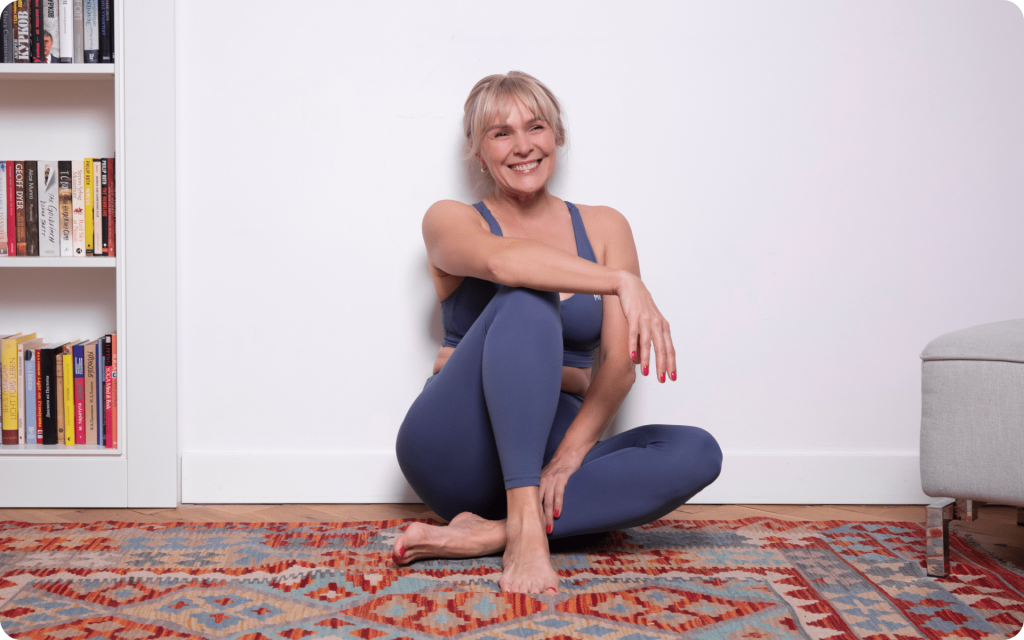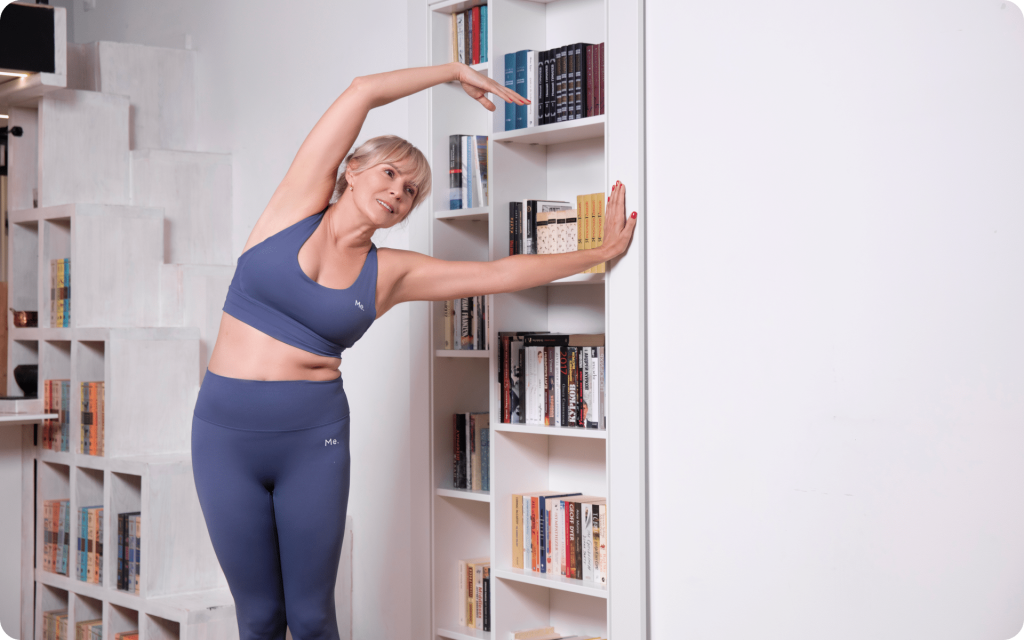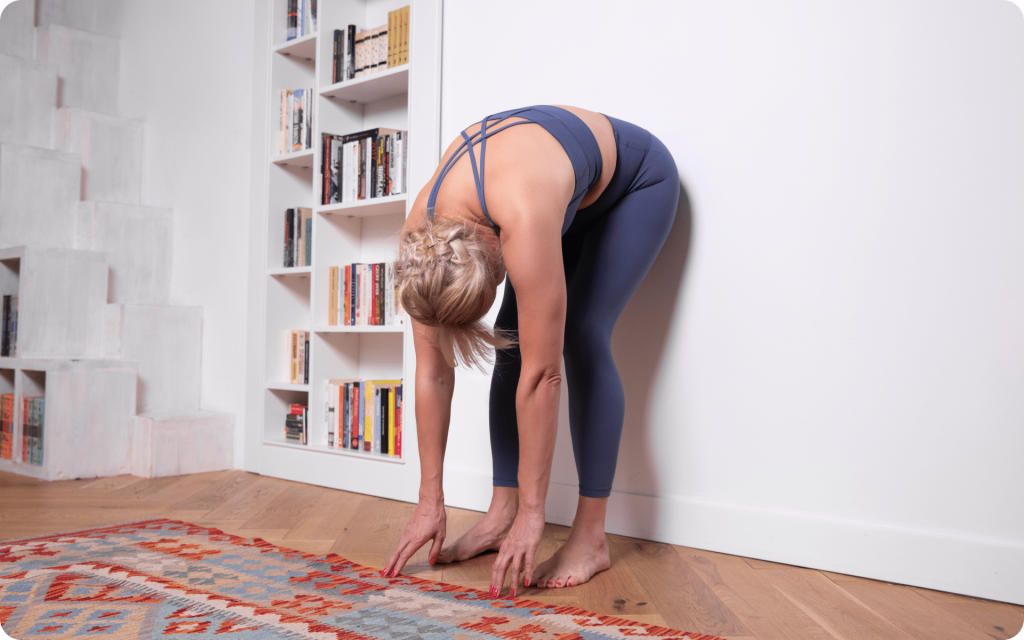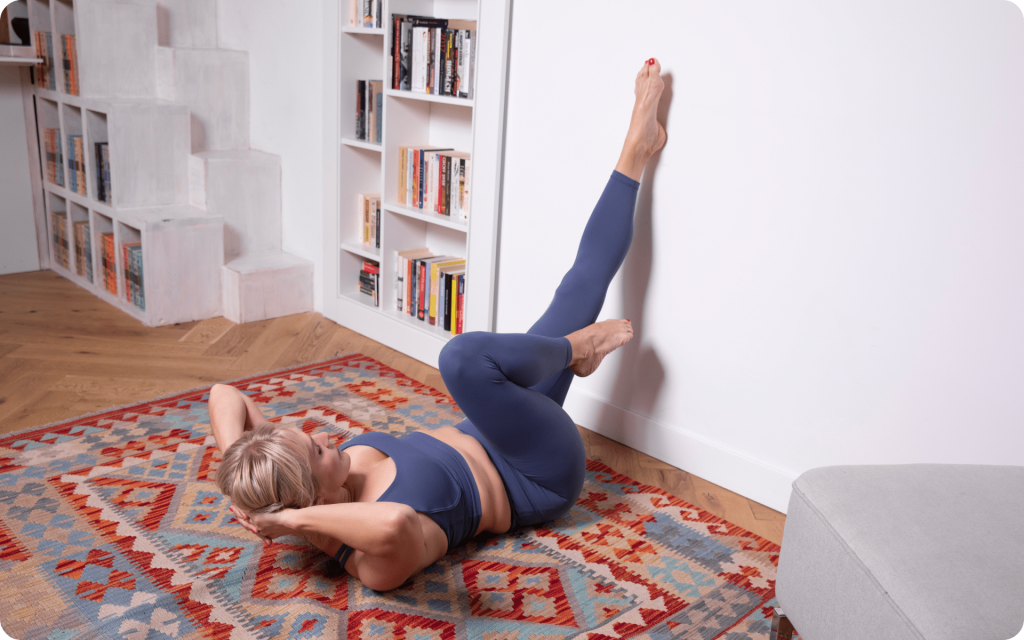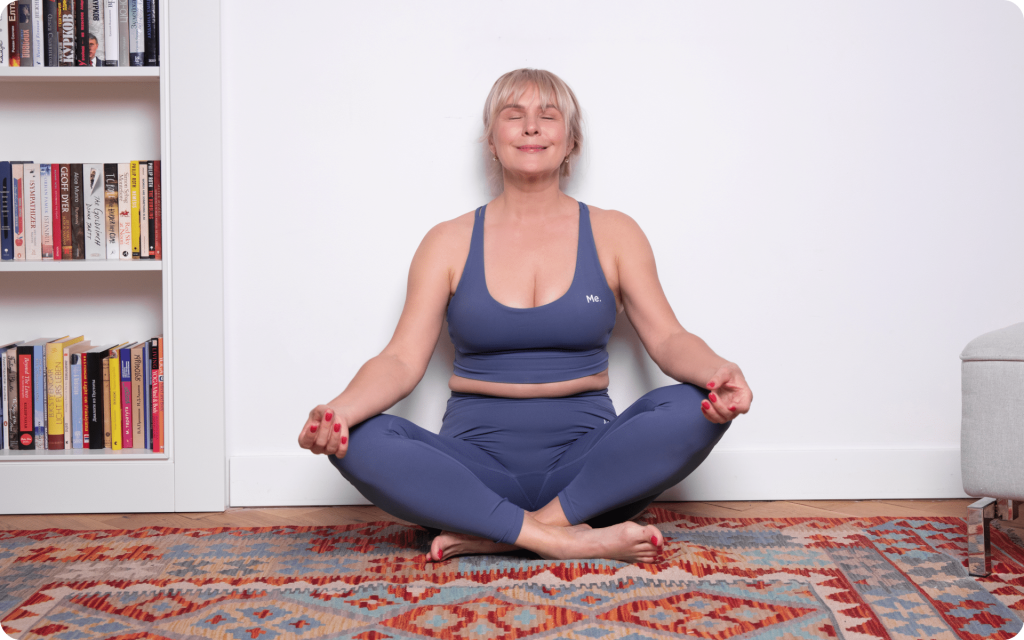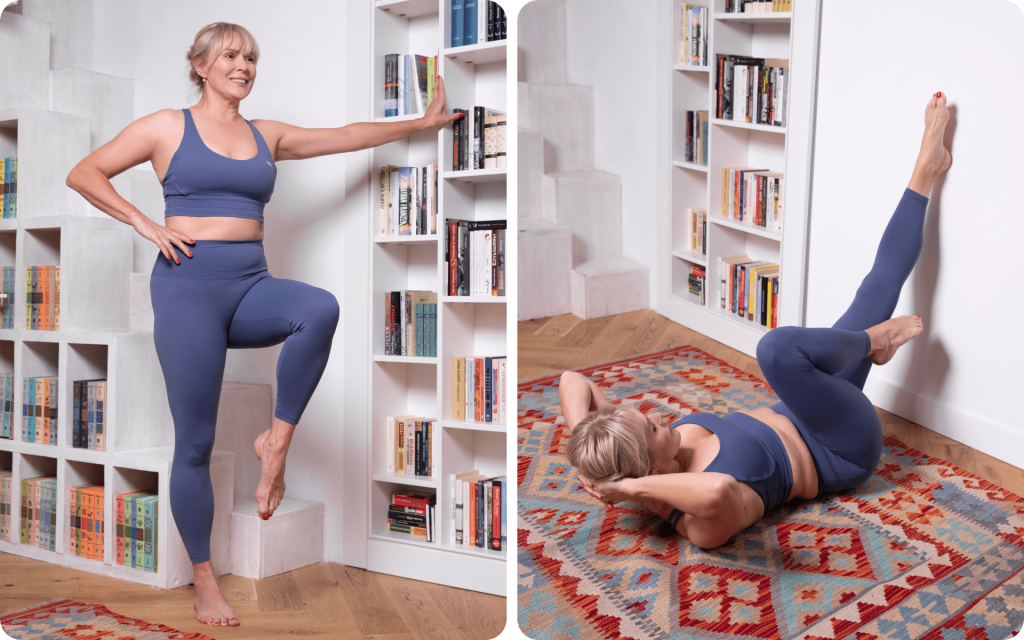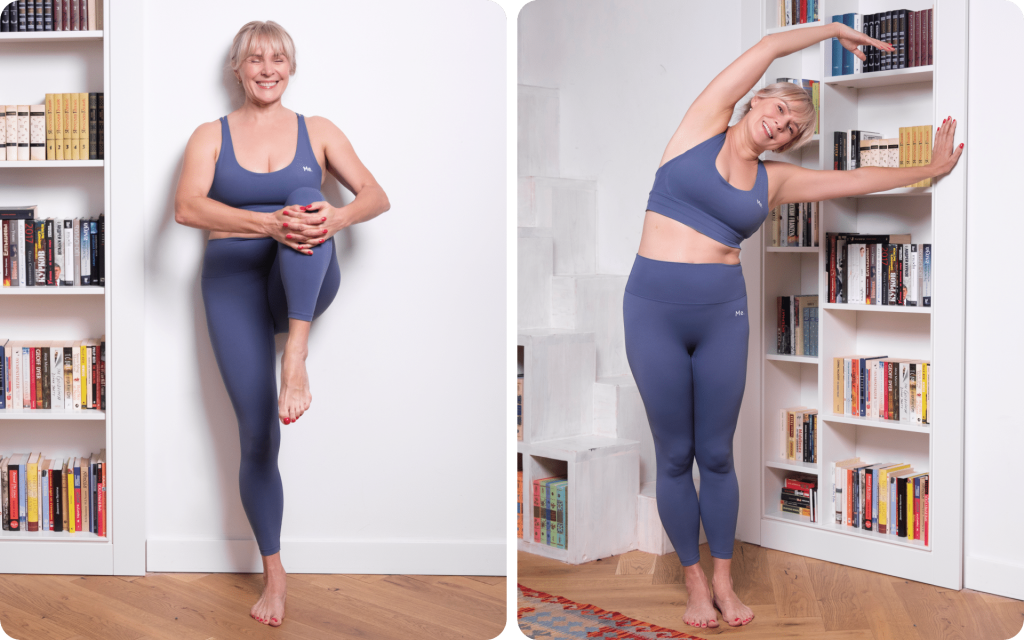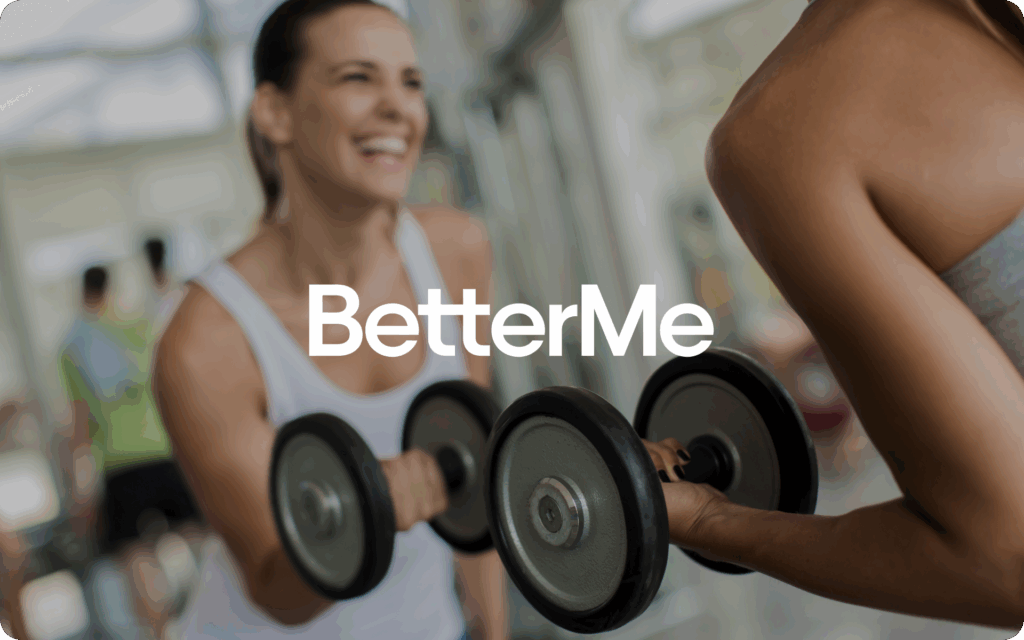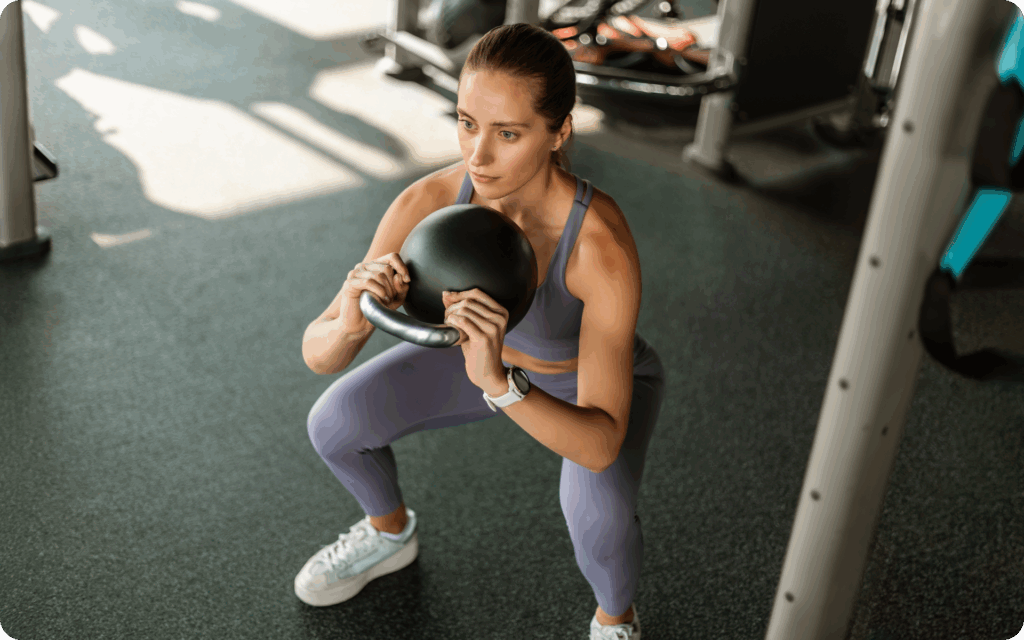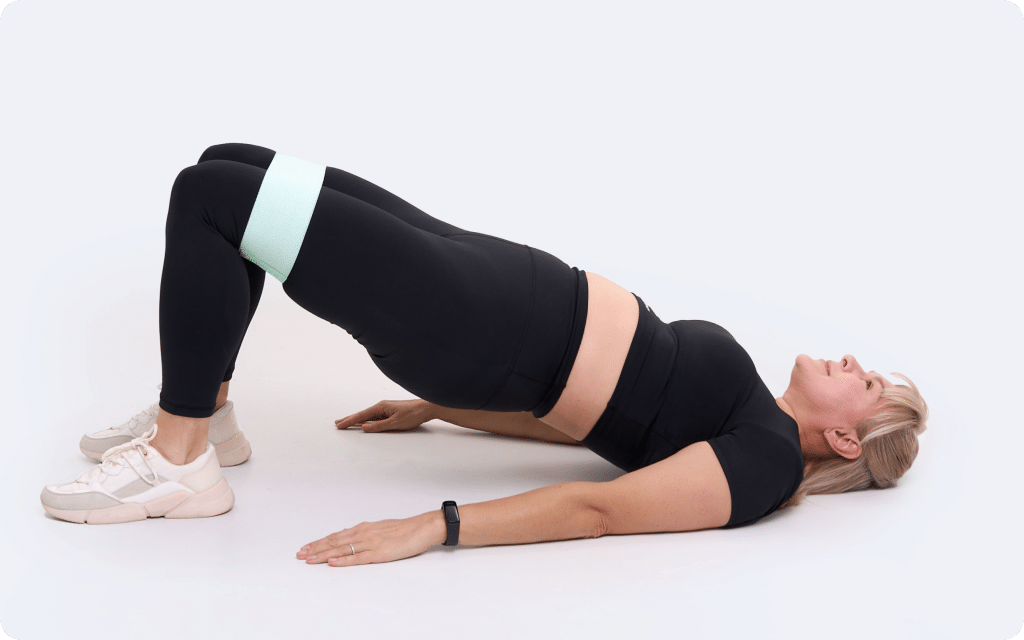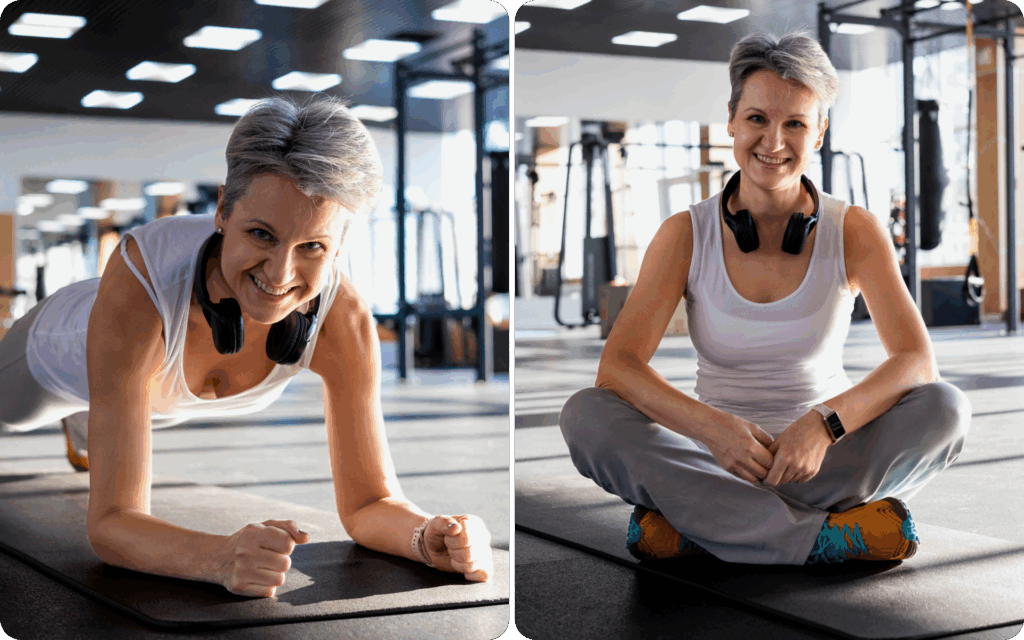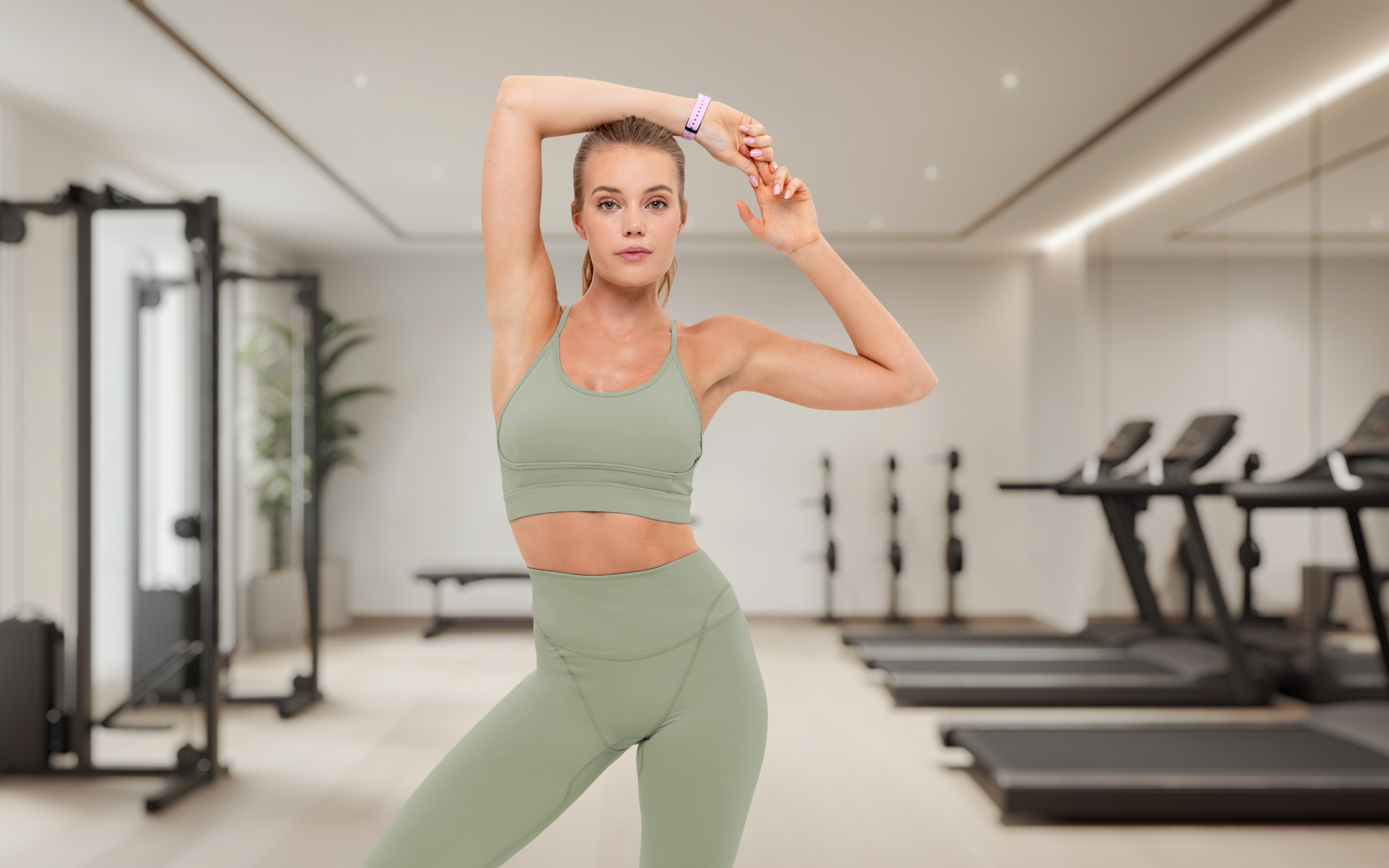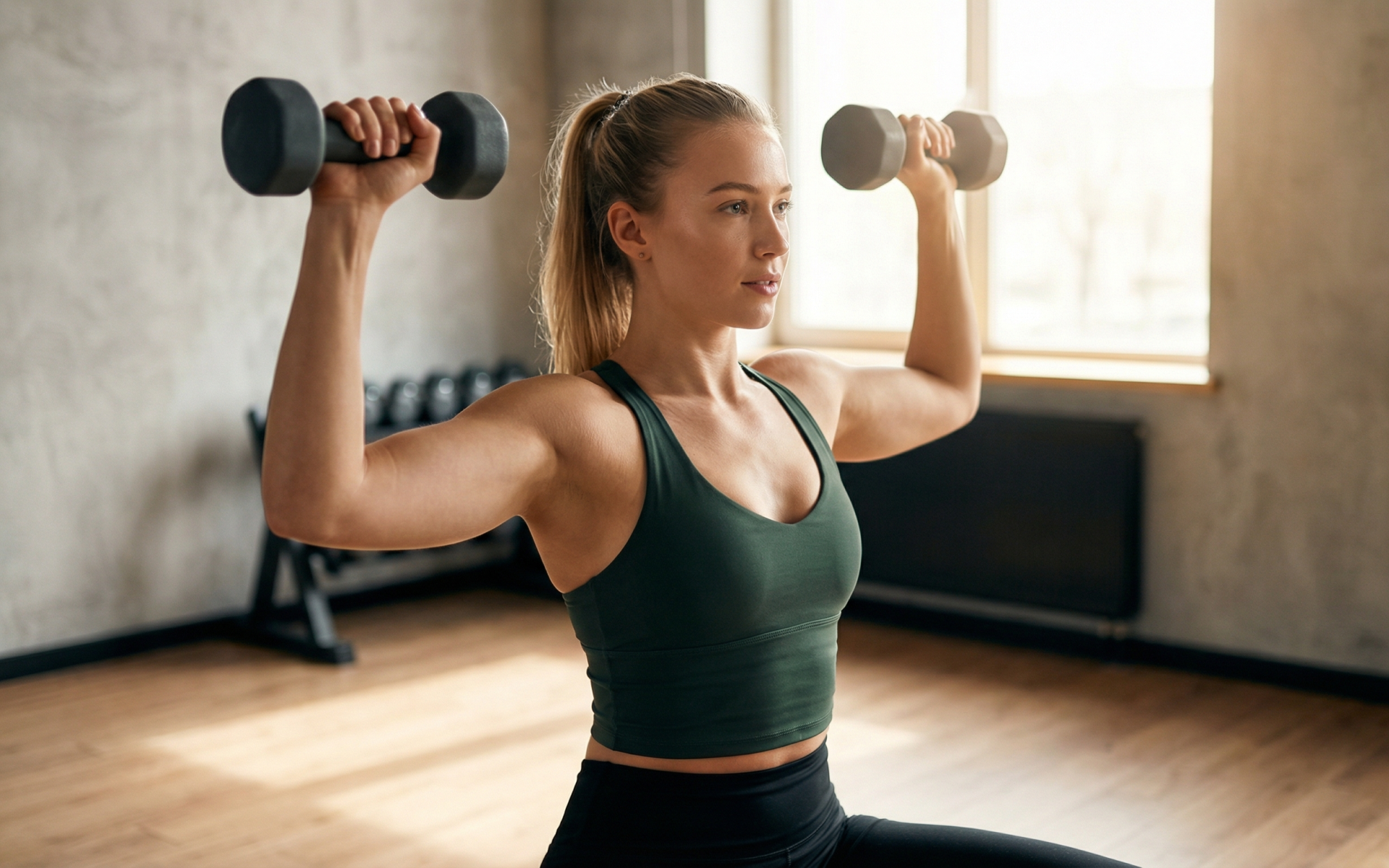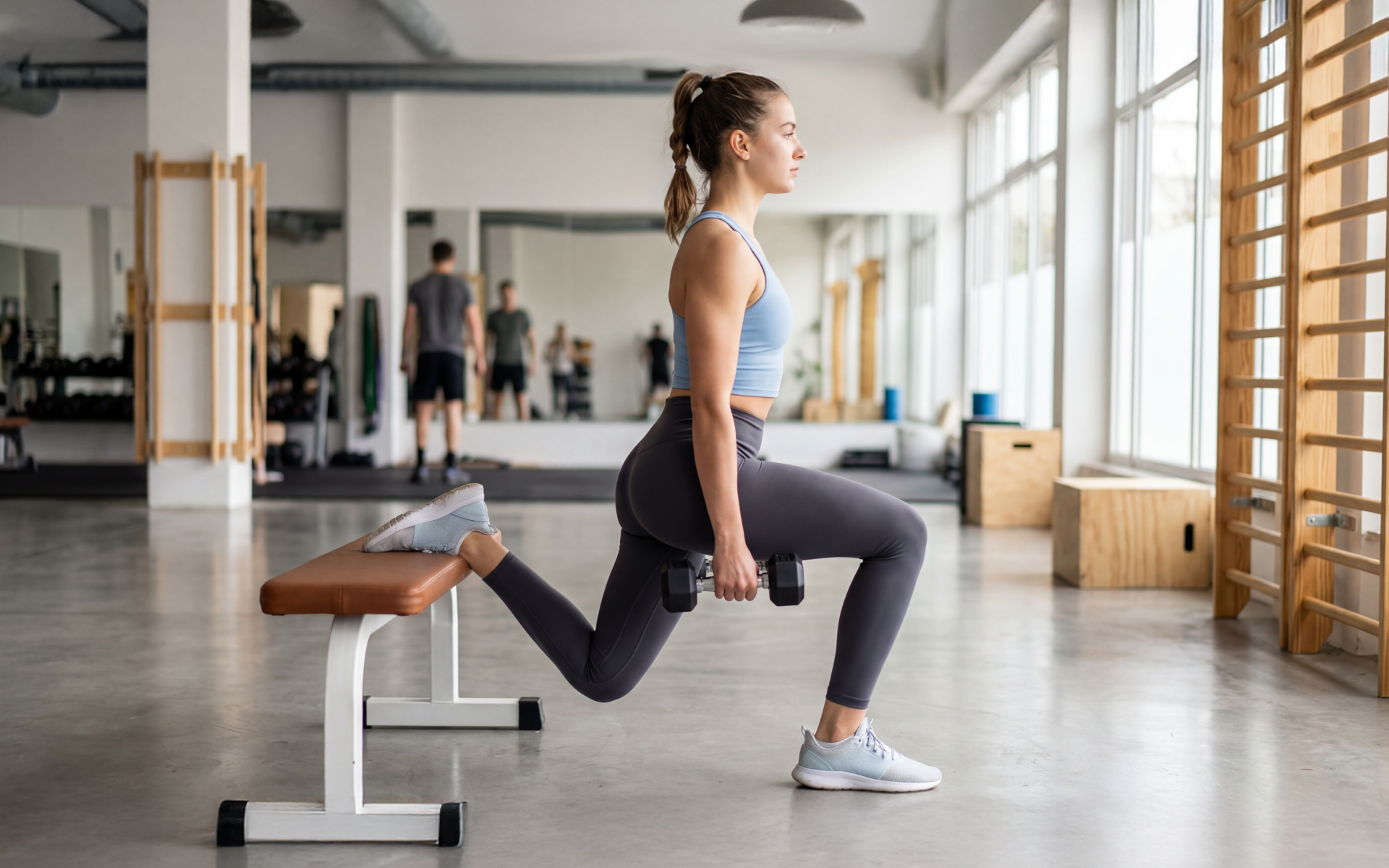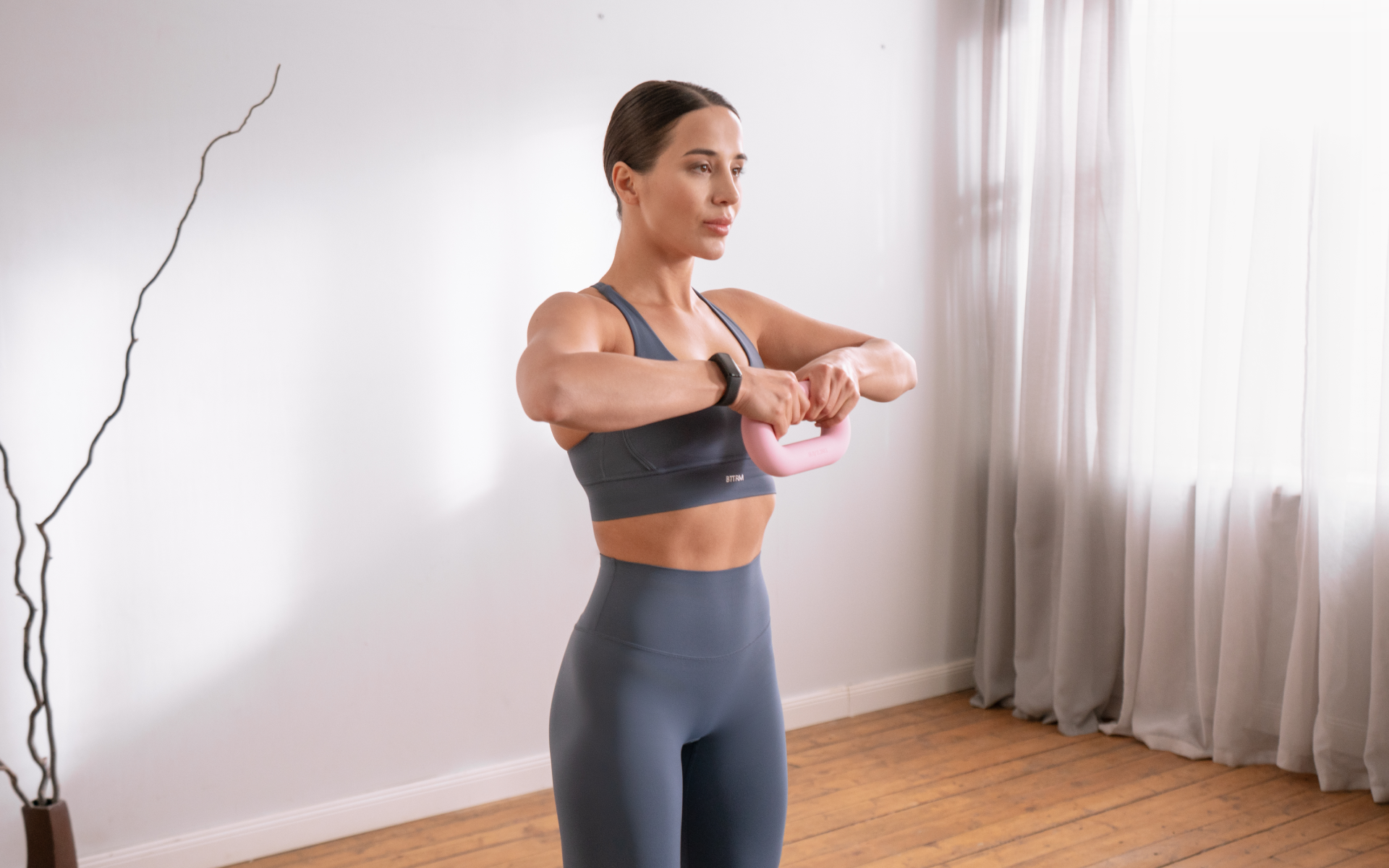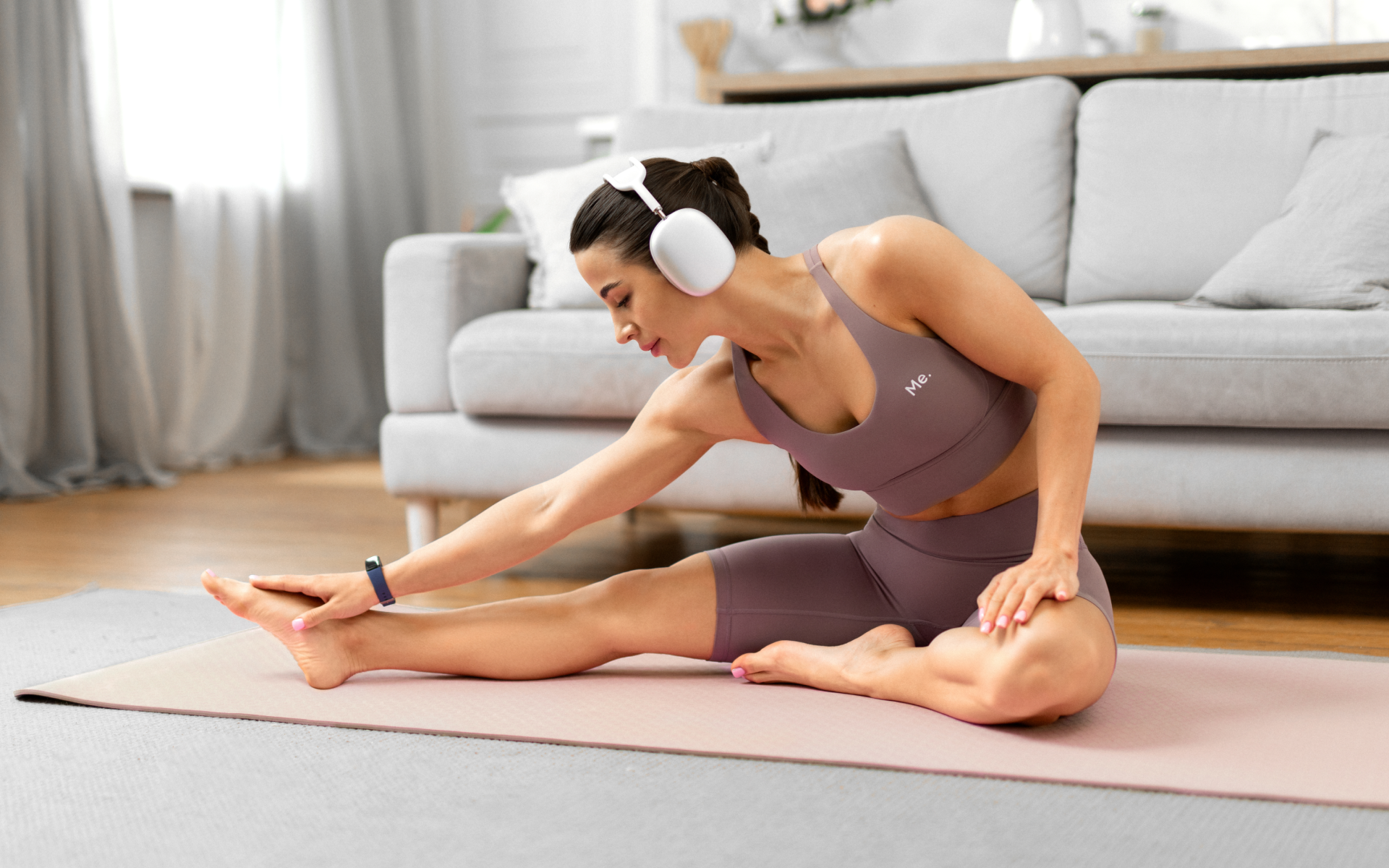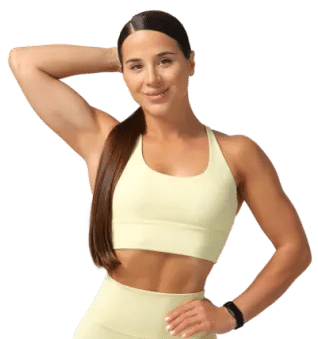Starting a fitness journey after 50 can feel intimidating. You may worry that you’re not strong, capable, or knowledgeable enough, but this is far from true. Your body at 50 possesses remarkable potential for transformation, strength gains, and improved health markers when approached with the right methodology.
This comprehensive guide presents a science-backed 12-week program that is designed specifically for women over 50. You’ll discover how to build strength, improve mobility, and enhance your overall well-being through structured training principles.
Can a 50-Year-Old Woman Get Back in Shape?
A 50-year-old woman can get back in shape. Research has consistently demonstrated that women over 50 can achieve significant improvements in strength, cardiovascular health, and body composition (1). Age shouldn’t be a barrier to fitness, but it should inform your training approach.
The Science Behind Midlife Fitness
Your body undergoes several changes during this decade. Muscle mass naturally decreases by approximately 8-15% per decade after age 40, with accelerated loss after menopause (2).
Bone density also declines, particularly during the first five years post-menopause. Hormonal shifts, particularly declining estrogen levels, affect fat distribution and metabolism (2).
This doesn’t mean weight management becomes impossible – it means your approach needs to be more strategic. The principle of individuality from strength training science reminds us that every person responds differently to exercise based on their biological age, training history, and current health status.
Breaking Down Barriers
Many women over 50 face psychological barriers that can be more limiting than physical ones. The fear of injury, concerns about looking out of place in a gym, or believing it’s “too late” to start can prevent progress. Evidence has shown that properly designed gym workout plans for older women are not only safe but essential for maintaining independence and quality of life (3).
The key is progressive overload – gradually increasing training demands while allowing adequate recovery. This principle applies regardless of your starting point, whether you’re returning to exercise after years of inactivity or looking to take your current routine to the next level.
Realistic Expectations
Getting “back in shape” means different things to different people. For some, it’s about regaining strength for daily activities, while for others, it’s about achieving a specific aesthetic goal. The most successful transformations focus on functional improvements that enhance overall quality of life while supporting long-term health goals.
Read more: 10 Gentle Abdominal Exercises for Seniors to Do at Home
How Long Does It Take for a 50-Year-Old Woman to Get in Shape?
The timeline for seeing results depends on several factors, but noticeable changes typically occur within 4-6 weeks of consistent training. However, understanding what constitutes “getting in shape” helps set realistic expectations for your transformation journey.
Weeks 1-4: Foundation Building
During weeks 1-4, your body adapts to new movement patterns and exercise demands. Initial improvements are largely neuromuscular – your nervous system becomes more efficient at recruiting muscle fibers (4). You’ll likely notice improved energy levels, better sleep quality, and enhanced mood before visible physical changes occur (5).
Strength gains during this period are primarily due to improved coordination and motor learning rather than actual muscle growth. This is normal and represents important progress that sets the foundation for future adaptations.
When it comes to weight loss, progress is made by inches, not miles, so it’s much harder to track and a lot easier to give up. The BetterMe: Health Coaching app is your personal trainer, nutritionist, and support system all in one. Start using our app to stay on track and hold yourself accountable!
Weeks 5-8: Visible Changes Emerge
This is when many women start to notice physical changes. Muscle definition becomes more apparent, and you may notice improvements in posture and movement quality. Cardiovascular improvements become evident as daily activities feel easier and recovery between exercises improves (6).
The principle of specificity suggests that adaptations occur in response to the specific demands placed on your body. If your program includes strength training for women over 50, you’ll see improvements in muscle tone and functional strength. If cardiovascular exercise is emphasized, you’ll notice enhanced endurance and stamina.
Weeks 9-12: Significant Transformations
By the third month, substantial changes in body composition, strength, and overall fitness become apparent. Research indicates that 12 weeks of consistent training can result in 10-20% increases in muscular strength and 8-12% improvements in cardiovascular fitness for previously sedentary women (7).
The timeline can vary based on several factors:
- Current fitness level and training history
- Consistency of exercise and nutrition habits
- Sleep quality and stress management
- Individual genetic factors and recovery capacity
Factors That Influence Progress
Recovery becomes increasingly important with age. The principle of progression emphasizes that training stimulus must gradually increase, but adequate rest remains essential. Women over 50 may require slightly longer recovery periods between intense training sessions compared to younger individuals (8).
Nutrition plays a crucial role in supporting adaptations. Adequate protein intake becomes particularly important for maintaining and building muscle mass (9). Hydration, sleep quality, and stress management all significantly impact your body’s ability to adapt to training demands.
Is It Possible to Get in Shape in 12 Weeks?
A realistic 3-month body transformation female plan can yield impressive results when it’s properly structured. The key is understanding what’s achievable within this timeframe while maintaining realistic expectations about the process.
What 12 Weeks Can Accomplish
Research supports significant improvements in multiple fitness parameters within 12 weeks. Studies have shown that previously sedentary women can achieve (7):
- 10-20% increases in their muscular strength
- 15-20% improvements in their cardiovascular fitness
- 5-10% reduction in their body fat percentage
- Improved bone density markers
- Enhanced functional movement capacity
These improvements translate to meaningful real-world benefits. Daily activities become easier, energy levels increase, and confidence in physical abilities grows. Many women report feeling stronger and more capable than they have in years.
- Structural Adaptations
Your body undergoes several positive adaptations during a 12-week program. Muscle protein synthesis increases, which leads to improved muscle quality and size. Cardiovascular adaptations include increased stroke volume and improved oxygen utilization (10). Bone density improvements begin, although these take longer to fully manifest.
The nervous system adapts rapidly, improving coordination, balance, and movement efficiency (6). These changes often translate to better performance in daily activities and reduced injury risk.
- Building Sustainable Habits
Perhaps more importantly, 12 weeks provides sufficient time to establish sustainable exercise habits. Research has suggested that it may take 59-154 days for a new behavior to become automatic (11). A 12-week program allows time to develop routines that support long-term success.
The principle of reversibility reminds us that fitness gains are lost when training stops. However, the habits and knowledge gained during a structured 12-week program provide the foundation for lifelong fitness maintenance.
- Managing Expectations
While 12 weeks can produce remarkable changes, it’s important to maintain realistic expectations. Dramatic physical transformations often require longer timeframes, particularly for women over 50 whose metabolisms and hormone profiles differ from those of younger individuals.
Focus on performance improvements and how you feel rather than solely on appearance changes. Celebrate increased strength, improved energy levels, and enhanced confidence as significant victories in your transformation journey.
What Exercise Burns the Most Belly Fat for Females over 50?
The question of targeting belly fat requires a nuanced, science-based response. While no single exercise specifically burns belly fat, certain training approaches are more effective for overall fat loss and metabolic health in women over 50.
The Truth About Spot Reduction
Spot reduction – the idea that you can target fat loss in specific body areas – isn’t supported by scientific evidence. Your body loses fat systematically based on genetic factors, hormonal influences, and overall energy balance (12). This doesn’t mean abdominal exercises are worthless, but rather that they should be part of a comprehensive approach. Our previous article covers everything you need to know about weight loss over 50.
For women over 50, hormonal changes often lead to increased abdominal fat storage (13). This visceral fat responds well to consistent exercise and proper nutrition, but the approach must be systemic rather than targeted.
Most Effective Exercise Types for Fat Loss
Strength Training for Overall Body Composition
Weight training for women over 50 provides the most significant impact on long-term fat loss. Muscle tissue burns more calories at rest than fat tissue, which makes strength training essential for maintaining metabolic rate (14). Compound movements such as squats, deadlifts, and rows engage multiple muscle groups simultaneously, maximizing caloric expenditure (15). Dive deeper into weight loss after 50 female with our dedicated article.
The principle of overload applies here – progressively increasing resistance, volume, or intensity – ensures continued adaptation and metabolic benefits (16). Full-body strength training sessions 2-3 times per week provide optimal stimulus for muscle maintenance and growth.
High-Intensity Interval Training (HIIT)
HIIT protocols alternate between high-intensity efforts and recovery periods. This approach burns significant calories during exercise and creates an “afterburn effect”, which has been found to keep your metabolism elevated for hours post-workout in a study with young men (17). For women over 50, HIIT should be progressed gradually and modified based on individual fitness levels.
Compound Movement Patterns
Exercises that engage multiple muscle groups simultaneously burn more calories and provide greater functional benefits (15). Squats, lunges, push-ups, and rowing movements activate your core while training other muscle groups, providing comprehensive conditioning.
The Role of Cardiovascular Exercise
While strength training provides the foundation for metabolic health, cardiovascular exercise supports overall fat loss and heart health.
The combination of strength training and cardiovascular exercise provides synergistic benefits for fat loss and overall health. This approach addresses multiple physiological systems while supporting long-term metabolic health.
- Hormonal Considerations
Cortisol, which is often called the stress hormone, can promote abdominal fat storage. Excessive high-intensity exercise can elevate cortisol levels, potentially counteracting fat loss efforts (19). This makes recovery, sleep, and stress management essential components of any fat loss program.
Insulin sensitivity often decreases with age, particularly around the midsection (20). Strength training improves insulin sensitivity, helping your body better utilize carbohydrates and support fat loss efforts (21).
- The Importance of Consistency
No single exercise burns belly fat, but consistent adherence to a well-designed program that includes strength training, cardiovascular exercise, and proper recovery creates the optimal environment for fat loss.
The principle of progression ensures your body continues to adapt to training demands.
Focus on building sustainable habits rather than searching for quick fixes. A comprehensive approach that addresses exercise, nutrition, sleep, and stress management provides the best foundation for long-term success.
What Is a Good 12-Week Workout Plan for a 50-Year-Old Woman?
A good 12-week program for women over 50 follows a progressive upper/lower split performed four days per week. This approach balances adequate stimulus for muscle growth and strength gains with sufficient recovery time – a crucial factor as recovery capacity changes with age.
Our program is divided into three distinct phases: Base (weeks 1-4), Strength (weeks 5-8), and Peak (weeks 9-12). Each phase builds upon the previous, gradually increasing intensity while maintaining proper form and joint health.
If you’ve never done a weightlifting program or regular exercise before, it would be best to start with only 3 exercises each day to ensure adequate time for your body to adapt to the new demands.
Program Structure
Training Split: Upper/lower-body split, 4 days per week
Days: Monday (upper), Tuesday (lower), Thursday (upper), Friday (lower)
Rest Days: Wednesday, Saturday, Sunday
Duration: 45-60 minutes per session
Phase 1: Base Building (Weeks 1-4)
Week 1-2: 3 sets of 12-15 repetitions at 60-65% perceived effort
Week 3-4: 3 sets of 10-12 repetitions at 65-70% perceived effort
Phase 2: Strength Development (Weeks 5-8)
Week 5-6: 3 sets of 8-10 repetitions at 70-75% perceived effort
Week 7-8: 4 sets of 6-8 repetitions at 75-80% perceived effort
Phase 3: Peak Performance (Weeks 9-12)
Week 9-10: 4 sets of 5-6 repetitions at 80-85% perceived effort
Week 11-12: 3 sets of 8-10 repetitions at 70-75% perceived effort (deload)
Upper-Body Training Days
Dumbbell Chest Press
The dumbbell chest press serves as the primary pushing movement for upper-body development. This exercise targets the pectorals, anterior deltoids, and triceps while providing unilateral training benefits that address potential strength imbalances.
Exercise Steps:
- Lie on a bench with dumbbells at chest level, your palms facing forward.
- Press the weights directly above your chest, maintaining a neutral wrist position.
- Lower the weights with control until a slight stretch is felt across your chest.
- Press back to the starting position, focusing on squeezing your chest muscles.
Bent-Over Dumbbell Row
This fundamental pulling exercise strengthens the latissimus dorsi, rhomboids, and posterior deltoids while improving posture, which is particularly important for women over 50 who may experience forward head posture from daily activities.
Exercise Steps:
- Stand with your feet hip-width apart, holding dumbbells at your sides.
- Hinge forward at the hips, maintaining a neutral spine.
- Pull the dumbbells toward your lower ribcage, squeezing your shoulder blades together.
- Lower the weights with control, feeling a stretch in your lat muscles.
BetterMe: Health Coaching app helps you achieve your body goals with ease and efficiency by helping to choose proper meal plans and effective workouts. Start using our app and you will see good results in a short time.
Overhead Dumbbell Press
This vertical pressing movement develops shoulder strength and stability while engaging the core. The seated variation provides additional support for those with lower-back concerns.
Exercise Steps:
- Sit on a bench with back support, holding dumbbells at shoulder height.
- Press the weights directly overhead, avoiding a forward head position.
- Lower the dumbbells with control to ear level.
- Press back to the starting position, maintaining core engagement.
Lat Pulldown
The lat pulldown provides a controlled pulling movement that’s easier to scale than pull-ups while targeting the same muscle groups. This exercise strengthens the latissimus dorsi and improves grip strength.
Exercise Steps:
- Sit at a pulldown station with your thighs secured under a pad.
- Grasp the bar with your hands slightly wider than shoulder-width apart.
- Pull the bar to your upper chest, focusing on pulling your elbows down and back.
- Control the weight back to the starting position with your arms fully extended.
Dumbbell Bicep Curls
Bicep curls provide targeted arm development while improving grip strength and elbow joint stability. The standing variation engages core muscles for additional stability benefits.
Exercise Steps:
- Stand with your feet hip-width apart, holding dumbbells at your sides.
- Curl the weights toward your shoulders, keeping your elbows stationary.
- Squeeze your biceps at the top of the movement.
- Lower the weights with control, fully extending your arms.
Lower-Body Training Days
Goblet Squat
The goblet squat teaches proper squatting mechanics while providing a full-body strength challenge. Holding weight at chest level promotes upright posture and core engagement.
Exercise Steps:
- Hold a dumbbell or kettlebell at chest level.
- Stand with your feet slightly wider than shoulder-width apart.
- Lower into a squat position, keeping your chest up and your knees tracking over your toes.
- Drive through your heels to return to a standing position.
Romanian Deadlift
The Romanian deadlift targets the posterior chain – hamstrings, glutes, and erector spinae – while teaching proper hip hinge mechanics. This movement pattern is essential for daily activities and injury prevention.
Exercise Steps:
- Stand with your feet hip-width apart, holding dumbbells in front of your thighs.
- Push your hips back while lowering the weights, maintaining a slight knee bend.
- Feel a stretch in your hamstrings, then drive your hips forward to return to standing.
- Keep the weights close to your body throughout the movement.
Walking Lunges
Walking lunges develop unilateral leg strength while challenging balance and coordination. This functional movement pattern mimics daily activities such as climbing stairs.
Exercise Steps:
- Stand with your feet hip-width apart, holding dumbbells at your sides.
- Step forward into a lunge position, lowering until both knees reach 90 degrees.
- Push off your front foot to bring your back leg forward into the next lunge.
- Continue alternating legs for the prescribed number of repetitions.
Calf Raises
Calf raises strengthen the gastrocnemius and soleus muscles while improving ankle stability and balance – crucial factors for fall prevention in women over 50.
Exercise Steps:
- Stand on the balls of your feet at the edge of a step or platform.
- Lower your heels below step level, feeling a stretch in your calves.
- Rise up onto your toes, squeezing your calf muscles.
- Control your descent back to the starting position.
Glute Bridges
Glute bridges activate the gluteus maximus while teaching proper hip extension patterns. This exercise addresses common glute weakness and helps alleviate lower-back discomfort.
Exercise Steps:
- Lie on your back with your knees bent, your feet flat on the floor.
- Squeeze your glutes and lift your hips, creating a straight line from your knees to your shoulders.
- Hold briefly at the top position.
- Lower your hips with control, maintaining glute tension.
How Many Days a Week Should a 50-Year-Old Woman Work Out?
Research indicates that women over 50 (and particularly those over 60) should engage in structured resistance training at least twice a week and up to 3-4 times per week to see optimal results (22). It’s typically recommended to do strength training on non-consecutive days to allow adequate recovery between sessions.
Four training days per week provides the ideal balance between stimulus and recovery. This frequency allows for sufficient volume to promote muscle growth and strength gains while preventing overtraining – a particular concern as recovery capacity changes with age.
Additional considerations include:
Cardiovascular Training: 2-3 days per week of moderate-intensity cardio on non-strength training days
Active Recovery: Light walking, yoga, or stretching on rest days
Complete Rest: At least one full day of rest per week
The key principle is consistency over intensity. Regular, moderate training sessions produce better long-term results than sporadic high-intensity workouts that may lead to injury or burnout.
Yes, many women achieve their best physical condition after 50. While certain physiological changes occur with aging, muscle strength, cardiovascular fitness, and body composition can all improve significantly with proper training. The key lies in consistent, progressive exercise combined with adequate nutrition and recovery. Muscle protein synthesis – the process by which muscles repair and grow – remains responsive to exercise stimulus throughout life (23). Research has shown that women in their 50s and beyond can achieve substantial strength gains and cognitive improvements, often exceeding those of younger individuals who train inconsistently (3). Weight loss of 1-2 pounds per week is considered safe and sustainable (24), which makes 12-24 pounds of weight loss realistic over 12 weeks. However, the scale doesn’t tell the complete story. Resistance training often leads to muscle gain together with fat loss, which results in improved body composition even when total weight changes are modest. Focus on multiple metrics: how your clothes fit, your energy levels, your strength improvements, and your body measurements. These indicators often provide a more accurate picture of progress than weight alone. Both cardiovascular exercise and resistance training are essential for women over 50. Resistance training takes priority due to its role in maintaining muscle mass, bone density, and metabolic rate – all of which decline with age without intervention. The optimal approach combines both: 3-4 days of resistance training with 2-3 days of moderate cardiovascular exercise. This combination addresses multiple health factors while providing variety to prevent boredom and overuse injuries. Three to four weight training sessions per week on non-consecutive days will provide optimal results for women over 50. This frequency allows adequate recovery between sessions while providing sufficient stimulus for strength and muscle gains. Recovery becomes increasingly important with age, which makes rest days between training sessions essential for adaptation and progress. Quality sleep, proper nutrition, and stress management support the recovery process and enhance training outcomes.Frequently Asked Questions
Can I get in the best shape of my life at 50?
Can I lose noticeable weight in 12 weeks?
Should I do cardio or weights after 50?
How often should a 50-year-old lift weights?
The Bottom Line
Your fitness journey at 50 represents an opportunity to redefine what’s possible. This 12-week program provides the structure and scientific backing to achieve remarkable improvements in strength, health, and quality of life.
Remember that transformation extends beyond physical changes. The confidence, energy, and resilience you’ll develop through this program will positively impact every area of your life. You’re not just building a stronger body, you’re also creating a foundation for vibrant health that will serve you for several decades to come.
DISCLAIMER:
This article is intended for general informational purposes only and does not serve to address individual circumstances. It is not a substitute for professional advice or help and should not be relied on for making any kind of decision-making. Any action taken as a direct or indirect result of the information in this article is entirely at your own risk and is your sole responsibility.
BetterMe, its content staff, and its medical advisors accept no responsibility for inaccuracies, errors, misstatements, inconsistencies, or omissions and specifically disclaim any liability, loss or risk, personal, professional or otherwise, which may be incurred as a consequence, directly or indirectly, of the use and/or application of any content.
You should always seek the advice of your physician or other qualified health provider with any questions you may have regarding a medical condition or your specific situation. Never disregard professional medical advice or delay seeking it because of BetterMe content. If you suspect or think you may have a medical emergency, call your doctor.
SOURCES:
- Improved Physical Fitness Among Older Female Participants in a Nationally Disseminated, Community-Based Exercise Program (2012, pmc.ncbi.nlm.nih.gov)
- The role of estrogen in female skeletal muscle aging: A systematic review (2023, sciencedirect.com)
- Effects of 8-Weeks Concurrent Strength and Aerobic Training on Body Composition, Physiological and Cognitive Performance in Older Adult Women (2020, mdpi.com)
- Neuromuscular adaptations to strength training (n.d., us.humankinetics.com)
- Exercise Physiology (n.d., physio-pedia.com)
- Adaptations to Endurance and Strength Training (2018, pmc.ncbi.nlm.nih.gov)
- The Effect of a 12-Week Health Training Program on Selected Anthropometric and Biochemical Variables in Middle-Aged Women (2017, onlinelibrary.wiley.com)
- Age-Associated Differences in Recovery from Exercise-Induced Muscle Damage (2024, mdpi.com)
- International Society of Sports Nutrition Position Stand: protein and exercise (2017, jissn.biomedcentral.com)
- Effects of different exercise interventions on heart rate variability and cardiovascular health factors in older adults: a systematic review (2021, link.springer.com)
- Time to Form a Habit: A Systematic Review and Meta-Analysis of Health Behaviour Habit Formation and Its Determinants (2024, mdpi.com)
- Spot reduction: why targeting weight loss to a specific area is a myth (2023, sydney.edu.au)
- Adverse Changes in Body Composition During the Menopausal Transition and Relation to Cardiovascular Risk: A Contemporary Review (2022, pmc.ncbi.nlm.nih.gov)
- Increasing muscle mass to improve metabolism (2013, pmc.ncbi.nlm.nih.gov)
- Compound Exercises (n.d., physio-pedia.com)
- Effects of Resistance Training Overload Progression Protocols on Strength and Muscle Mass (2024, pubmed.ncbi.nlm.nih.gov)
- Excess Post-Exercise Oxygen Consumption and Substrate Oxidation Following High-Intensity Interval Training: Effects of Recovery Manipulation (2021, pmc.ncbi.nlm.nih.gov)
- Zone 2 Intensity: A Critical Comparison of Individual Variability in Different Submaximal Exercise Intensity Boundaries (2025, onlinelibrary.wiley.com)
- A Narrative Review on Adipose Tissue and Overtraining: Shedding Light on the Interplay among Adipokines, Exercise and Overtraining (2024, mdpi.com)
- Age-related changes in insulin sensitivity and β-cell function among European American and African American women (2011, pmc.ncbi.nlm.nih.gov)
- The effect of exercise training on adipose tissue insulin sensitivity: A systematic review and meta-analysis (2022, onlinelibrary.wiley.com)
- The Intensity and Effects of Strength Training in the Elderly (2011, pmc.ncbi.nlm.nih.gov)
- Age-related differences in the dose–response relationship of muscle protein synthesis to resistance exercise in young and old men (2008, pmc.ncbi.nlm.nih.gov)
- Key Recommendations (n.d., nhlbi.nih.gov)

